When it comes to winter garden, do you think of the dark, depressing atmosphere? Then, it would help if you dived into our article to explore and choose plants which are the most colorful and vibrant winter-blooming. They can withstand harsh weather condition, offering a delightful burst of winter color when the rest of the garden remains dormant.
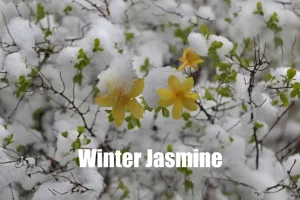
Winter Jasmine
Winter jasmine, with its bright yellow flowers, is an evergreen shrub for dreary winter. Its delicate white flowers provide a beautiful contrast against the dark foliage, making it a standout feature during the winter months. However, it may not be so fragrant compared to other jasmine types!
Growing Tips
Winter jasmine grows best in USDA hardiness zone 6-10 thrives in well-drained soil and a sunny location for optimal growth. Regular pruning helps maintain its shape and encourages abundant blooms in late winter or early spring.
Combination
Complement the beauty of winter jasmine by pairing it with other winter bloomers such as winter heath, aconite, or snowdrop. These combinations ensure a diverse and captivating winter flower garden, providing color to your garden and interest throughout the winter months.
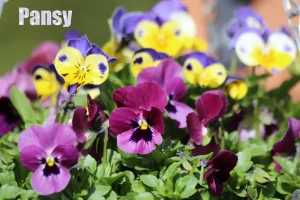
Winter Flower Pansy
Pansies are perennial flowers blooming in late winter to early spring as they tolerate even in colder temperatures. They are evergreen, featuring heart-shaped petals, but come in a wide range of colors, including bright red, pink, yellow, purple, and white. The distinct foliage of pansies adds an ornamental color to the winter garden, making them an excellent choice for adding color and interest during the colder months.
Growing Tips
Pansies are in the group of the USDA hardiness zone 6-10 and require well-drained soil with sunny location to ensure healthy growth. They are best suited for late fall planting, allowing them to be established before winter. Regular deadheading and fertilization promote continuous blooming throughout the hardy wintertime, providing a beautiful display of vibrant winter flowers.
Combination
Complement the beauty of pansies by pairing them with other winter bloomers such as snowdrops, winter heath, and crocuses. These companion plants create a diverse and captivating winter flower garden, offering an array of colors, shapes, and textures that contribute to a flourishing garden during the winter months.
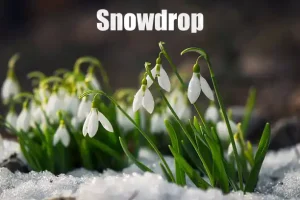
Snowdrop
Snowdrops, also known as Galanthus, are charming and resilient winter bloomers appreciated for their ability to thrive in the coldest months. They are often called “the rose of winter”, serving as a symbol of hope and renewal. Their bright pink or white flowers and narrow, bell-shaped foliage contribute to their unique and graceful appearance. Snowdrops often early appear in late winter, often heralding the arrival of spring and adding a delicate touch to the winter landscape.
Growing Tips
These hardy perennials thrive in well-drained soil and can be grown in partial shade to full sun, suitable for planting in USDA hardiness zone 3 to 7, depending on the specific climate and cultivar. Snowdrops are known for their resilience and ability to naturalize, spreading gracefully over time and adding an enchanting carpet of blooms during late winter and early spring.
Combination
Pair snowdrops with other late winter bloomers such as yellow winter aconite, hellebore, mahonia, bright red berries and winter jasmine to create a stunning winter garden display. With their varying colors and forms, these companion plants add depth and charm to the garden, ensuring a flourishing and diverse landscape during the colder months.
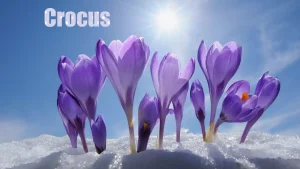
Crocus
Crocus is a genus of flowering plants in the iris family, Iridaceae, comprising 90 species of perennials growing from corms. Their flowers, as the glory of the snow, herald the arrival of spring with an array of vibrant colors. These hardy winter bloomers, available in shades of white, purple, yellow, and striped variations, make an enchanting addition to the winter garden, offering a burst of color when most plants remain dormant.
Growing Tips
Plant the corms in well-drained, humus-rich soil to cultivate healthy crocuses, ensuring a sunny or partially shaded location. Additionally, provide adequate moisture during the growing season but avoid water logging, which can cause the corms to rot. Crocuses are winter hardy in zone 3-7, producing charming carpets of blooms that persist from late winter to early spring.
Combination
Consider pairing crocuses with companion plants such as winter aconite, snowdrops, and winter jasmine to create a delightful and diverse winter flower garden. These combinations offer a stunning display of colors and forms, enriching the garden with abundant winter blooms and seasonal interest.
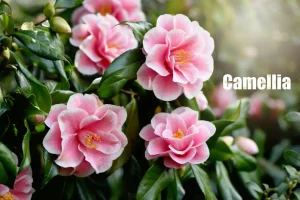
Camellia
Camellias are evergreen shrubs or small trees that bear exquisitely beautiful, rose-like flowers in the shades of red, white or pink flowers. These ornamental winter flowers and glossy, dark-green foliage add elegance and charm to the garden during the colder months, providing an iconic floral display when few other plants bloom.
Growing Tips
Camellias are cold hardy to USDA Zone 8, which can tolerate low temperature of 10 to 15 degrees. For flourishing camellias, ensure they are planted in moist, well-drained, acidic soil with partial shade or filtered sunlight. Mulching and regular watering in drier periods benefit their growth and blooming. Pruning, preferably after flowering, helps maintain the desired shape and encourages robust blooming the following season.
Combination
Enhance the visual appeal of camellias by combining them with companion plants such as winter jasmine, witch hazel, and winter heath. These combinations provide a diverse and captivating winter garden and ensure a splendid and flourishing landscape during the winter months.
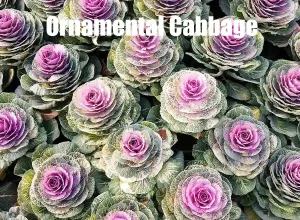
Ornamental Cabbage
Ornamental cabbage has stunning curly foliage that can endure winter in mild climates. Their edges are smooth with bright rose-like centers of purple, red, pink, or white leaves. They add a color to a garden during the most gray and gloomy days. Compared with other types of cabbage, it is also edible, but its ornamental taste is very bitter, so it is often used as a food decoration.
Flowering cabbage can be treat as annuals, as it is likely to bloom throughout the winter, every season year after year as long as not lower than -5 degrees.
Growing Tips
Flowering cabbage goes for the hardiness zone 2 to 11. Ensure the proper care of cabbage by growing them in moist, well-drained, acidic soil with ample afternoon sunlight. It is essential to provide light for germination, and they should be started by midsummer for late fall to early winter planting. Remember to fertilize with a time-released fertilizer.
Combination
Combine ornamental cabbage with companion plants such as flowering kale, snapdragons, and petunias, which can withstand frost during the winter. These combinations create a diverse and captivating winter garden and guarantee a beautiful and thriving landscape during the winter months.
Conclusion
In conclusion, incorporating winter flowers like crocuses and camellias can transform a garden into a visually stunning and ecologically enriching landscape. These resilient blooms and their companion plants contribute to a diverse and captivating winter flower garden, ensuring a flourishing and vibrant garden during cold hardy winter days.
